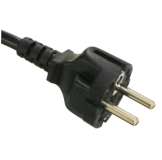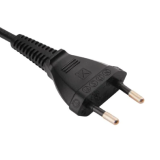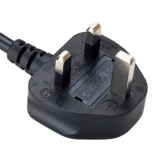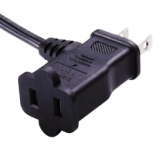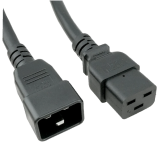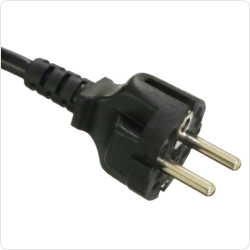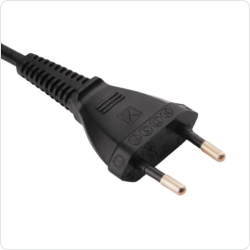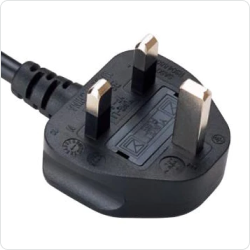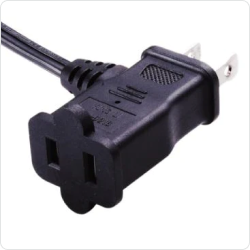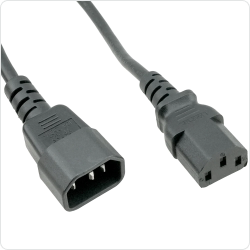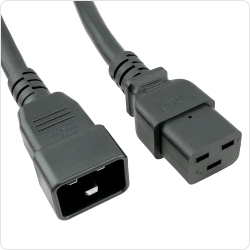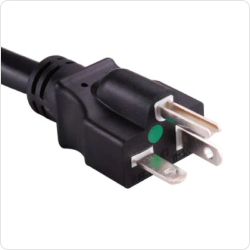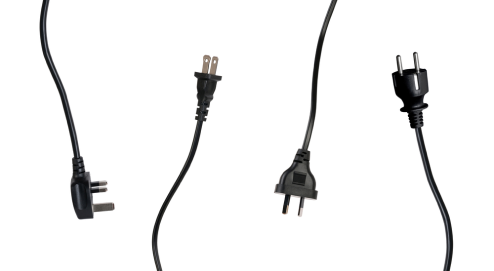
Power Cord Types: A Brief History & Introduction
There are hundreds of different power cord types across the world. In this article, we will talk about the ones you are most likely to encounter, along with a brief history of how they came into being.

Ivo Landre
Date Published: 21/10/2023
European CEE 7/7
More countries use the CEE 7/7 plug than any other country in the world. It’s used in a lot of European countries and some African countries.
The CEE 7/7 has two male round prongs and a female. With this standard, the grounding is done in two different ways:
This CEE 7/7 is used by approximately 104 countries around the world. It’s popular and practical — going up to 16 amps instead of just two-and-a-half amps, but it’s also kind of big and bulky.
The CEE 7/7 has two male round prongs and a female. With this standard, the grounding is done in two different ways:
- On the plug side there may be a female receptacle prong.
- Or there may be a ground strap on the top and bottom that achieves grounding (a third pin on the cord itself).
This CEE 7/7 is used by approximately 104 countries around the world. It’s popular and practical — going up to 16 amps instead of just two-and-a-half amps, but it’s also kind of big and bulky.
European CEE 7/16
The European CEE 7/16 is arguably the second most common type of European power cord type in use. It has two prongs, and is the European equivalent of the NEMA 1-15 power cord (more on that below).
The CEE 7/16 has no grounding. It consists of just two round pins. Some of the reasons behind its popularity are that it’s very small, and very applicable to small electrical products that do not require grounding. The CEE 7/16 is used far and wide, in 113 countries all over the world, from Afghanistan to Vietnam.
The CEE 7/16 has no grounding. It consists of just two round pins. Some of the reasons behind its popularity are that it’s very small, and very applicable to small electrical products that do not require grounding. The CEE 7/16 is used far and wide, in 113 countries all over the world, from Afghanistan to Vietnam.
UK BS 1363
The BS 1363 is the UK standard power cord type. The plug for a BS 1363 is much bigger than most other plug types, and actually has a fuse built into it.
The BS 1363 plug socket, in my opinion, is the best design around. And the reason I say that is because it’s the safest. The ground pin on BS 1363 cords is longer than the live neutral pins, so it always goes into the plug socket first. This really helps to prevent shock. On top of that, both the live and the neutral pins are insulated up to a certain point.
The only real downside is that BS 1363 cords are kind of bulky and heavy. It’s used in approximately 98 countries worldwide.
The BS 1363 plug socket, in my opinion, is the best design around. And the reason I say that is because it’s the safest. The ground pin on BS 1363 cords is longer than the live neutral pins, so it always goes into the plug socket first. This really helps to prevent shock. On top of that, both the live and the neutral pins are insulated up to a certain point.
The only real downside is that BS 1363 cords are kind of bulky and heavy. It’s used in approximately 98 countries worldwide.
NEMA 1-15
The NEMA 1-15 is a widespread two-prong cord commonly used in the United States and Japan — as well as a handful of other countries including Japan, Taiwan, and several central and South American countries.
The NEMA 1-15 became embedded early on, and virtually every electronic device uses either a polarized or unpolarized version of the 1-15. They remain enduringly popular because they are easy to acquire, abundantly available, and cheap because they’re manufactured in large quantities. The NEMA 1-15 is in use in 43 countries globally.
Behind the 1-15, the three-pronged NEMA 5-15 (15 amp) is perhaps the second most common type of NEMA power cord.
The NEMA 1-15 became embedded early on, and virtually every electronic device uses either a polarized or unpolarized version of the 1-15. They remain enduringly popular because they are easy to acquire, abundantly available, and cheap because they’re manufactured in large quantities. The NEMA 1-15 is in use in 43 countries globally.
Behind the 1-15, the three-pronged NEMA 5-15 (15 amp) is perhaps the second most common type of NEMA power cord.
IEC C13 to C14
The IEC C13 to C14 power cord (specification 60320) is by far the most popular type of IEC power cord. The specification number refers to a series of power cord specifications overseeing everything from male and female connectors, the number of pins (e.g. two pin, three pin), and the amperage (low or high).
The IEC C13 to C14 power cord in the United States can be rated up to 15 amps at 125 volts, and in most cases this still is fully sufficient for most devices, hence the popularity.
You will find the IEC C13 to C14 power cord on the back of every computer, monitor and lots of other devices such as overhead projectors.
The IEC C13 to C14 power cord in the United States can be rated up to 15 amps at 125 volts, and in most cases this still is fully sufficient for most devices, hence the popularity.
You will find the IEC C13 to C14 power cord on the back of every computer, monitor and lots of other devices such as overhead projectors.
IEC C19 to C20
Over the last two decades or so, more and more devices have come onto the market with a greater demand for power. For example, the amount of computing power required for running AI models is exponentially larger than even 18 months ago.
In fact, computing power doubles approximately every two years (following Moore's Law), a trend that consistently fuels the need for higher-density data centers, and hardware that requires more power and to be able to extract more efficiency out of a limited data center space.
To respond to this challenge, the C13 to C14 is slowly starting to be phased out in favor of the more powerful IEC C19 to C20.
Today, it’s not uncommon to find servers that are 20 amps instead of 15 amps. EV charging stations are often 32 amps or higher. You can see the transition happening almost in real time in the data center world, in the evolution of the PDU strips.
When PDU strips first came out, they were almost entirely made up of C13 to C14 connectors. Then it became more common to see a PDU strip of 80/20 C13 to C14 and C19 to C20. Today, PDU strips in data centers are far more likely to be a 50/50 split to accommodate C19 to C20 power cord types.
In fact, computing power doubles approximately every two years (following Moore's Law), a trend that consistently fuels the need for higher-density data centers, and hardware that requires more power and to be able to extract more efficiency out of a limited data center space.
To respond to this challenge, the C13 to C14 is slowly starting to be phased out in favor of the more powerful IEC C19 to C20.
Today, it’s not uncommon to find servers that are 20 amps instead of 15 amps. EV charging stations are often 32 amps or higher. You can see the transition happening almost in real time in the data center world, in the evolution of the PDU strips.
When PDU strips first came out, they were almost entirely made up of C13 to C14 connectors. Then it became more common to see a PDU strip of 80/20 C13 to C14 and C19 to C20. Today, PDU strips in data centers are far more likely to be a 50/50 split to accommodate C19 to C20 power cord types.

Different power cords used across the world
This section is a brief overview. To get a full list of what power cord types are used and where, check out our table of countries and plug types here.
CEE power cord types
Most countries on the European continent use CEE types of power cables and specifically CEE 7/7 but there are exceptions.
Denmark has its own standard. Italy has its own standard (which is also used in Chile). Switzerland has its own standard too, which is very similar to Italy’s but with the center prong staggered up.
Countries far and wide outside of Europe also use these types of power cords for electronics, from Azerbaijan to Madagascar to Togo.
You’ll find CEE 7/7 power cords and plug sockets everywhere in day-to-day life where they’re used. For example, if you plug a device into the wall in one of these countries, or use an extension cord, it’s likely to be a CEE 7/7 one.
Denmark has its own standard. Italy has its own standard (which is also used in Chile). Switzerland has its own standard too, which is very similar to Italy’s but with the center prong staggered up.
Countries far and wide outside of Europe also use these types of power cords for electronics, from Azerbaijan to Madagascar to Togo.
You’ll find CEE 7/7 power cords and plug sockets everywhere in day-to-day life where they’re used. For example, if you plug a device into the wall in one of these countries, or use an extension cord, it’s likely to be a CEE 7/7 one.
UK BS power cords
One legacy of Britain’s empire is the type of plug socket it left behind. Outside of the United Kingdom itself, you will find BS 1363 cords and plugs in countries as far and flung as Bangladesh, Malaysia and Zimbabwe.
NEMA power cords
In the 43 countries that have adopted the NEMA standard (from the United States to Micronesia to Venezuela), you’ll find NEMA power cords and plug sockets everywhere in day-to-day life. For example, if you plug a device into the wall, or use an extension cord, it’s likely to be a NEMA one.
IEC power cords
IEC codes and power cords are predominantly used in data centers around the world. An IEC on both ends, a male and a female, has its biggest application by far in a datacom or telecom center.
That’s because router switches, hubs, server racks, they all usually require an intelligent PDU power strip to function in a data center, and each of these PDUs may have up to 32 devices safely plugged into them at any one time.
That’s because router switches, hubs, server racks, they all usually require an intelligent PDU power strip to function in a data center, and each of these PDUs may have up to 32 devices safely plugged into them at any one time.
NEMA medical-grade power cords
Most countries have no standard for medical grade or hospital grade cords, but in the United States we do. Normally this involves making a more robust version of a particular power cord (say, for example the NEMA 5-15), and subjecting it to several tests to see if it is durable enough for the job.
Medical grade power cords look identical to their non-medical counterparts, except they have a bright green dot on them to show they have been rigorously tested. The connectors on hospital grade power cords have to be soldered and not crimped. They have to be of a durability that large and heavy items (such as crash carts) can be maneuvered over them, without a risk of damage between the wire and the terminals.
It’s probably easier to think of them as ‘heavy-duty’ cords. You will also find them in warehouses and other industrial industries.
Medical grade power cords look identical to their non-medical counterparts, except they have a bright green dot on them to show they have been rigorously tested. The connectors on hospital grade power cords have to be soldered and not crimped. They have to be of a durability that large and heavy items (such as crash carts) can be maneuvered over them, without a risk of damage between the wire and the terminals.
It’s probably easier to think of them as ‘heavy-duty’ cords. You will also find them in warehouses and other industrial industries.
Good to know:
For whatever reason, Europe, the UK, and most other countries have not set a standard for medical grade power cord applications.
There are people that market their products as medical grade for, say, Europe or the UK, but it's just made up marketing. There's no written standard that they're conforming to with their tests.
Instead, for industrial, hospital, or higher power requirements typically pin and sleeve are used, such as IEC 60309 pin and sleeve products. This can involve some huge connectors, from 3-5 pin, with an amperage range from 16-128 amps.
There are people that market their products as medical grade for, say, Europe or the UK, but it's just made up marketing. There's no written standard that they're conforming to with their tests.
Instead, for industrial, hospital, or higher power requirements typically pin and sleeve are used, such as IEC 60309 pin and sleeve products. This can involve some huge connectors, from 3-5 pin, with an amperage range from 16-128 amps.

A history of power cord types
Now that we’ve touched briefly on the most popular power cord types across the world, it’s worth exploring how they came to be so prominent in the first place.
You might be wondering why we even bother with all these different standards when we have the IEC (International Electrotechnical Commission) standard. To put it simply, the answer is because the world is a complex place and everybody has their own ways of doing things.
You might be wondering why we even bother with all these different standards when we have the IEC (International Electrotechnical Commission) standard. To put it simply, the answer is because the world is a complex place and everybody has their own ways of doing things.
A brief history of the IEC standard
Over the past 117 years, several international standards have been proposed by the IEC (International Electrotechnical Commission). The emerging field of electrotechnology was taking the world by storm, and key individuals in Britain, France and the United States were advocating international standards in the late nineteenth century.
The first International Electric Conference was held in 1881, in Paris, France (source). A culmination of these efforts led to the formation of the IEC in 1906, but throughout its history, it has notably failed in its targets of universalisation.
In 1986 the IEC proposed a particular plug and cord designed “to provide a standard for a safe, compact and practical… plugs and socket-outlets that could be accepted by many countries as their national standard, even if not in the near future (source).”
The problem is, only Brazil adopted the IEC’s ambitious design. It is literally the only country in the world that uses the NBR 14136 and NBR 6147.
The trouble with trying to create a one-world standard is that it takes enormous planning and for everyone to agree to implement. Just imagine the cost of having to bring every building up to new standards across the world. Instead, the history of power cords is a bit of a haphazard one, with countries setting up their standards on what was easiest for them to adopt at the time.
It’s why a hodgepodge of countries use the United State’s NEMA standard, and why Italy and Chile share a common power cord type. In my opinion, there probably won’t ever be a true international standard. Or at least, not for a very long time.
The first International Electric Conference was held in 1881, in Paris, France (source). A culmination of these efforts led to the formation of the IEC in 1906, but throughout its history, it has notably failed in its targets of universalisation.
In 1986 the IEC proposed a particular plug and cord designed “to provide a standard for a safe, compact and practical… plugs and socket-outlets that could be accepted by many countries as their national standard, even if not in the near future (source).”
The problem is, only Brazil adopted the IEC’s ambitious design. It is literally the only country in the world that uses the NBR 14136 and NBR 6147.
The trouble with trying to create a one-world standard is that it takes enormous planning and for everyone to agree to implement. Just imagine the cost of having to bring every building up to new standards across the world. Instead, the history of power cords is a bit of a haphazard one, with countries setting up their standards on what was easiest for them to adopt at the time.
It’s why a hodgepodge of countries use the United State’s NEMA standard, and why Italy and Chile share a common power cord type. In my opinion, there probably won’t ever be a true international standard. Or at least, not for a very long time.
A brief history of the NEMA standard
The IEC was founded in 1906, at a time when the United States and Canada already had a burgeoning electrical infrastructure and standards already in place.
The first centralized power station came online in New York City in 1882 (source) and regulation quickly began through the American Institute of Electrical Engineers, an organization that was established in 1884 (source).
Rather than make the transition to IEC, the decision was made to double-down on those standards and better regulate them. The result was the establishment of the National Electrical Manufacturers Association (NEMA) in 1926 (source).
That being said, where possible, NEMA standards have been developed to be used alongside IEC standards. A key example of this would be in data center PDUs (as mentioned above).
Most countries around the world have their own standards up to a point — usually only up to 16 amps — and after that default to IEC 6309 pin and sleeve standards instead (for example, for high-powered commercial industrial applications).
Everybody takes this approach, except for America and other NEMA standard countries — because they don't have any definitions. They don't have any NEMA definitions of what you use in 20 amps, 30 amps, 40 amps, 50 amp situations.
So everybody worldwide uses pin and sleeve except for NEMA counties. In America, we have all these NEMA standards, for example straight blade standards, and twist and lock standards. For two-a-half-amp, 15 amp, 20, 30, 40, 50 amp, and so on. So there's tons of NEMA standards. And, most of the definitions are found in NEMA’s UL specifications (which in turn are mostly based on NEC standards). NEMA came up with these standards, but they based it on the NEC standard.
The first centralized power station came online in New York City in 1882 (source) and regulation quickly began through the American Institute of Electrical Engineers, an organization that was established in 1884 (source).
Rather than make the transition to IEC, the decision was made to double-down on those standards and better regulate them. The result was the establishment of the National Electrical Manufacturers Association (NEMA) in 1926 (source).
That being said, where possible, NEMA standards have been developed to be used alongside IEC standards. A key example of this would be in data center PDUs (as mentioned above).
NEMA, a very thorough organization
NEMA has a lot of specifications that define how plugs and receptacles should be used, ranging from two-and-a-half amps up to 60 amps. This thoroughness sets NEMA apart from much of the rest of the world.Most countries around the world have their own standards up to a point — usually only up to 16 amps — and after that default to IEC 6309 pin and sleeve standards instead (for example, for high-powered commercial industrial applications).
Everybody takes this approach, except for America and other NEMA standard countries — because they don't have any definitions. They don't have any NEMA definitions of what you use in 20 amps, 30 amps, 40 amps, 50 amp situations.
So everybody worldwide uses pin and sleeve except for NEMA counties. In America, we have all these NEMA standards, for example straight blade standards, and twist and lock standards. For two-a-half-amp, 15 amp, 20, 30, 40, 50 amp, and so on. So there's tons of NEMA standards. And, most of the definitions are found in NEMA’s UL specifications (which in turn are mostly based on NEC standards). NEMA came up with these standards, but they based it on the NEC standard.
A brief history of the United Kingdom’s BS 1363 standard
The BS 1363 standard was published in 1947, after long discussions with representatives from the electrical agency, safety organizations and government agencies (source).
It was developed to address a previous lack of standardization, as well as some safety fears with prior designs — and formally mandated by the UK Government in 1958 (source).
Here is an example of the UK Government traveling in its own direction, and consciously choosing to develop a standard specific to its own electrical systems and needs, irrespective of IEC recommendations.
That being said, the European Committee for Electrotechnical Standardization (CENELEC), which was founded in 1973 has encouraged the adoption of the CEE 7 standard. In fact, its mission statement is to “help facilitate trade between countries, create new markets, cut compliance costs and support the development of a Single European Market” (source). The result is that most countries across Europe use CEE 7 today.
A part of this movement towards CEE 7 was through compromise. Germany and France initially had different standards — CEE 7/4 and CEE 7/5 — and they decided to make a hybrid of the two, one that would work for both of them (CEE 7/7).
It was developed to address a previous lack of standardization, as well as some safety fears with prior designs — and formally mandated by the UK Government in 1958 (source).
Here is an example of the UK Government traveling in its own direction, and consciously choosing to develop a standard specific to its own electrical systems and needs, irrespective of IEC recommendations.
A brief history of the European CEE standards
The European CEE 7 standards were proposed in 1951 originally, and last modified in 1983 (source). Unsurprisingly, there are lots of different standards that vary from nation-to-nation across Europe. To the extent that, as a result, there has been no attempt by the EU to enforce a universal standard across its member states.That being said, the European Committee for Electrotechnical Standardization (CENELEC), which was founded in 1973 has encouraged the adoption of the CEE 7 standard. In fact, its mission statement is to “help facilitate trade between countries, create new markets, cut compliance costs and support the development of a Single European Market” (source). The result is that most countries across Europe use CEE 7 today.
A part of this movement towards CEE 7 was through compromise. Germany and France initially had different standards — CEE 7/4 and CEE 7/5 — and they decided to make a hybrid of the two, one that would work for both of them (CEE 7/7).
Make your own custom power cords with SIGNAL+POWER, a premier power cord & plug adapter manufacturer.
Looking for a custom variation of one of the common standard power cord types above, or a more uncommon equivalent?
We are a custom power cord and plug adapter manufacturer to OEMs in all types of industries.
We can make custom power cords that:
So whatever you need, be it small volume orders, or large quantities — we can deliver them over to you in a short time. For more information on all the custom products we make, click where it says ‘custom products’ in the menu navigation of our website.
We are a custom power cord and plug adapter manufacturer to OEMs in all types of industries.
We can make custom power cords that:
- Match the color you want
- Have special labels
- Meet the grade you’ll need (e.g. hospital grade)
So whatever you need, be it small volume orders, or large quantities — we can deliver them over to you in a short time. For more information on all the custom products we make, click where it says ‘custom products’ in the menu navigation of our website.





